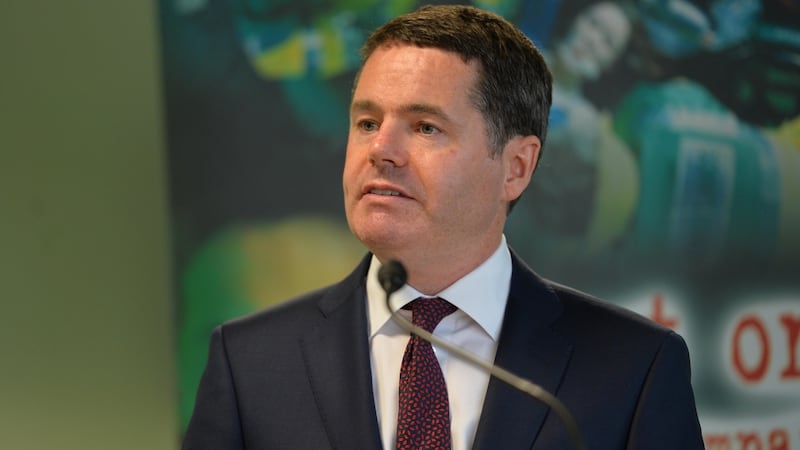The exchequer finances are pretty straightforward. Cash comes in, largely via tax, and goes out again in spending, either on providing services or State investment. Right now tax revenues are buoyant and the decision taken is to spend them, rather than cut taxes. This was an out and out spending budget.
Total voted spending is set to rise by more than 6 per cent next year, with extra resources poured into housing and health in particular. The clear choice to allocate additional resources to spending and so income tax cuts in 2019 are very limited. Overall in 2019 the tax burden on the economy will rise, with budget tax-raising measures outflanking tax cuts by around two to one.
The Government can spend more because tax revenues are rising fast. Tax next year will be 5.2 per cent ahead of 2018, according to the budget forecasts and that is after a late surge in corporation tax pushed this year's total well ahead of target. And we are spending the money as soon as it is coming in. Last June, when the Department of Finance published its economic outlook it anticipated that gross current (or day-to-day) spending next year would be €57.3 billion. Now the target is €59.3 billion.
For spending to keep increasing at this rate, we need taxes to keep rising. If there is any sudden economic downturn, spending plans would, sooner or later, have to be adjusted. The most obvious danger in 2019 is a no-deal Brexit, where the UK leaves the EU with no withdrawal agreement, leading to sudden changes in trade arrangements from next March. This could bring forward a lot of the costs of Brexit into a short period starting next year. The backdrop is that Ireland’s high debt level reduces our room for manoeuvre in the event of a shock and leaves us reliant on the markets to refinance borrowings.
Rainy day fund
It would be wrong to portray the Government as going crazy with the exchequer finances. Such is the buoyancy of revenue that the Minister for Finance, Paschal Donohoe, has been able to plan for higher spending while at the same time aiming to keep the budget in balance next year, for the first time since 2007. He is also setting aside €500 million as a contribution to a new rainy day fund.
EU budget rules now restrain our room for manoeuvre in terms of spending and borrowing and the Minister pointed out that day-to-day spending will rise at slightly less than the anticipated rate of economic growth in 2019. However, this is on top of an overrun in 2018.

The Government got lucky that a change in international tax rules led to a big surprise influx of corporate tax this year, adding to the buoyancy which has seen tax under this heading double since 2014. But while there is no particular reason to expect a collapse in corporate revenues, the reliance on 10 companies for some 40 per cent of this revenue creates obvious risks, if there is some upheaval in the tech sector or even problems affecting a particular company. And EU tax rule changes remain a threat. There is a clear case for moving the exchequer further into surplus in the next few years, assuming fair economic conditions and the Minister indicated he would aim to do this.
For next year, some €2.6 billion in additional spending was already allocated before budget day, much of it on increased State investment, which is increasingly massively. Economically, there is a case for this, provided the higher spending generates an economic and social return. The cuts in investment during the crash have left huge holes in our infrastructure – literally, in some cases – and rapid growth has added to pressures. But for the Government it is all about delivery and the political problem is that investment takes time – a lot of time.
Reasons for caution
Increasing current spending carries more budgetary risks, as it is an ongoing commitment and requires taxes to stay buoyant to pay the bills. Current spending will increase by 4 per cent next year, after a rise of 5.4 per cent last year, with the Department of Health leading the way with a 5.8 per cent increase for 2019. Politically, the Government needs to show that the massive ramping up of health spending is starting to make an inroad into the key problems. It also needs to ensure that the health budget is properly controlled. After all, we can't rely on a late inflow of tax to balance the books every year.
On budget day itself, spending was increased further. The Minister raised another €715 million in tax revenue to help pay for modest tax reductions of €365 million and new spending of another €1.4 billion. While the Minister did his best to talk up the tax package, it looks like it was scaled back in recent weeks as the sums got tight. In the event many middle earners will get only €4 to €5 extra from the basic changes. And remember that wage increases next year mean that many earners will be pushed into the higher tax band and the adjustments taking place are not enough to account for this.
So there is no big reduction on the horizon for taxpayers as the Government banks on them to pay for the spending boom. And the spending plans require the economy to remain buoyant. We have seen in the past how volatile Irish tax revenues can be in the face of changes in economic growth. With the world economy likely to slow in the next few years, interest rates rising, some euro zone tremors from Italy and Brexit, there are plenty of reasons for caution. We must hope it leads to a slow phasing back of the growth rates seen in recent years here to more sustainable levels. Just don't call it a soft landing.










